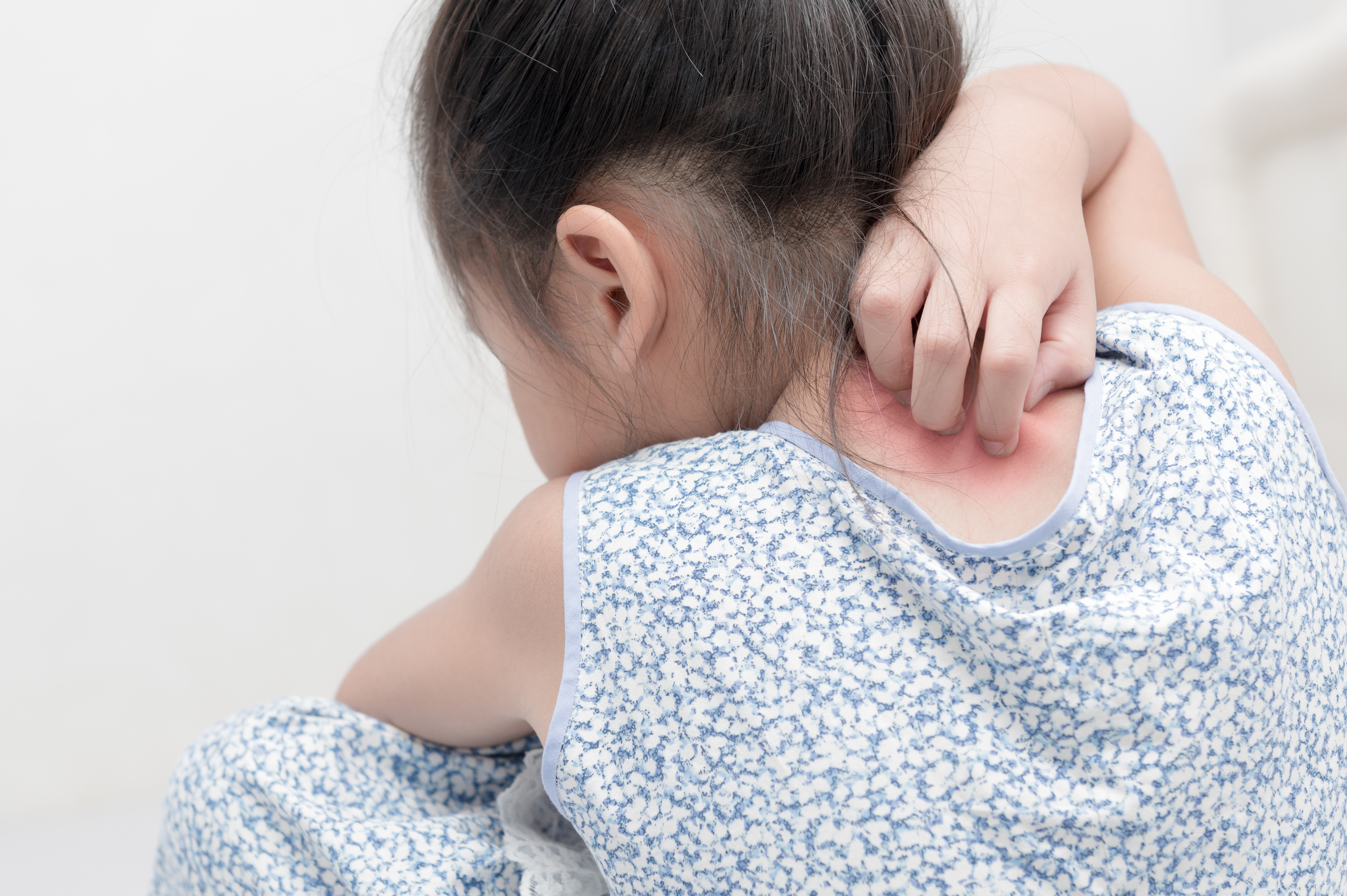
Eczema can affect a child’s quality of life in more ways than just itchy skin.
Kids have an increased risk of eczema, especially when there is a family history of it, with allergies and asthma.
The effects of this can cause behavioural issues like irritability, anxiety, and depression.
Not good.
In fact, a recent study has shown that 50% of kids who suffer from eczema have emotional symptoms, and not just itchy skin.
Considering how many of our kids have mental health issues these days, getting on top of eczema early should be a high priority for any parent.
Eczema in kids can show up anywhere on the body, however the face and scalp are most affected in infants from 3 months old.
Toddlers who suffer from eczema from 2-3 years of age will generally show areas around the back of knees, and creases in elbows and wrists.

But what are the causes of eczema in kids?
Factors that may trigger eczema in kids are the following;
ENVIRONMENT; frequent use of anti-bacterial wipes and soaps, personal care products with chemicals in them, chemical cleaning products used around the house. It’s called the “hygiene hypothesis”, which many researchers think means that our obsession with cleanliness is driving up allergies and eczema in our kids.
GENETICS; although this is not the only underlying cause, it can significantly increase your child’s risk of developing eczema if a family member has allergies.
IMMUNE insufficiencies; an imbalance of your child’s immune system triggers eczema. Your child may also catch frequent colds and other infections.
GUT microbiome imbalance; bacteria and parasites may be producing too much histamine in your child’s body, which triggers a reaction like eczema. Leaky gut can also impact this.
DIET; I find that most people assume straight away that dairy is the trigger. Whilst it can be, more often high histamine foods will be causing your child’s eczema reaction.
All these factors need to be assessed in determining the cause of your child’s eczema.

Tips for Eczema Relief in Kids
Here are some tips to improve reduce the severity of the eczema and manage it a little easier;
– Reduce histamine foods in the diet (short term only). Results should be seen within 1-2 weeks. I’ve put a list below with more information about the low histamine diet for you.
– Get your child to eat a small portion of blueberries and apples daily. These foods have an anti-histamine effect.
– Give your child the right probiotic that has shown in research to work specifically on eczema. Lactobacillius rhamnosus GG (LGG) and Lactobacillius paracasei (LP-33) are 2 of the top probiotics studies shown can reduce eczema.
– avoid fermented foods in kids like sauerkraut and kombucha, as they are extremely high in histamine, and could make matters worse.
– Vitamin C daily, (dose depends on age), will act as an anti-histamine and promote skin healing.
– Zinc, (dose again depends on age) will promote skin healing, is a natural anti-bacterial and anti-parasitic, and helps heals a leaky gut (when taken with other nutrients). Zinc should only be used short term however, not continuously.
– Vitamin A and D, (dose again depends on age), balance your child’s immune response and promotes healthy immunity, as well as healing leaky gut.
– Glutamine, (dose again depends on age) ,-soothes the gut and helps repair leaky gut when taken with the nutrients above.
– Fish on a regular basis has been shown to help reduce inflammation and allergies.
– Avoid chemicals in your child’s environment. Buy chemical free cleaning and personal care products, reduce the use of pesticides, and use glassware for liquids and foods, not plastic, as much as possible.
This is the sort of information I regularly go through with my patients and parents, and I hope that you can get some good ideas from this.
If you can incorporate some of these changes, then hopefully you’ll see an improvement in your child’s symptoms.
However, if things aren’t getting better then some further gut health testing might be necessary.
I’ll often use a CDSA and PCR stool test, to gain a greater understanding of what’s happening in the gut microbiome to get some answers.
LOW HISTAMINE DIET
(not all kids react the same way to all of these foods. Some of them may be ok, however you may want to pull some of them out if they eat them frequently, to see if you get an improvement)
FOODS TO AVOID
Cocoa
Kombucha
Fruit juice
Vegetable juice
Fermented soy (miso, soy sauce, tempey, tamari)
Foods that contain yeast
Legumes
Peanuts
Aged cheese
Bananas
Citrus (lemon, lime, grapefruit, orange, mandarin)
Fermented and dried fruits
Strawberries
Raspberries
Kiwi
Papaya
Pineapple
Plums
Bone broths
Cured and smoked meats
Additives (colours, stabilisers, taste enhancers, MSG, flavourings)
Chocolate
All fermented foods
Liquorice
Preservatives (benzoates, sulphites)
Shellfish
Tinned fish
Smoked and cured fish
Eggplant
Pickle vegetables
Tomatoes
Spinach
Chilli
Capsicum
White potato
Low Histamine Recipe – NOMATO SAUCE RECIPE
I’ve popped the following recipe below for you, as a substitute for the family favourite bolognaise.
Give it a try, and hopefully they’ll enjoy it, and have less itchy skin too!
Ingredients
6 carrots, peeled and cut into chunks
1 beetroot, peeled and cut into chunks
1 large onion, cut into quarters
3 celery sticks cut into chunks
1 bay leaf
1 tsp Italian herbs
1/2 tsp of salt
1 1/2 cups of water
Directions
Put everything in a covered pot, bring to the boil, reduce heat to simmer until veges are soft.
Take out bay leaf and discard, blend with a bar mixer well until smooth and use as you would tomato sauce.
Thank you, best of luck
From Morgan
